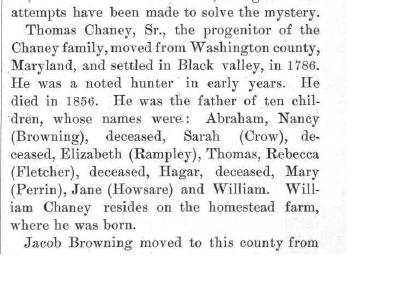
A brief biography of Pennsylvania resident Thomas Chaney appears in the 1884 history of Bedford, Somerset, and Fulton Counties. There are several things about the biography that serve as a reminder for conducting searches and using information contained in biographies of this type.
Several individuals mentioned in the biography are deceased at the time of its publication. Thomas Chaney, Sr. has been dead for thirty years by the time his biography appeared in the publication. Three of his children were deceased as well–including at least two who died after they were married. One should always look for people in print materials (especially county histories and newspapers) after they are known to be dead. Deceased people are written about years or decades after their death.
At least two of his daughters married after they had left Bedford County, Pennsylvania, marrying men in Coshocton County, Ohio, and later dying in western Illinois. Their last names appear in this Pennsylvania publication even though their husbands were not from Bedford County. Individuals appear in print materials from locations where they never lived one day in their life.

Printed biographies may provide few residential clues about some individuals mentioned in them. The only child of Thomas that the biography indicated lived in Bedford County, Pennsylvania, was son William. There is no suggestion as to where any of the other children lived. It is known that several of them left Pennsylvania when they were young adults. Don’t assume that a biography will provide all these details.
In some cases, biographees were charged by the word for their biographies. That forced some submitters to edit them heavily. Most biographies were not fact checked by editors and were taken at face value–warts and all.
When searching sites that have digital images of books and newspapers, keep in mind that your best reference to an individual may be in an item printed in a place where they never lived. And remember to not assume any fact about a person in a biography unless it’s specifically stated or an inference that is crystal clear.
And remember that what’s crystal clear to you may be clear as mud to someone else.

No responses yet